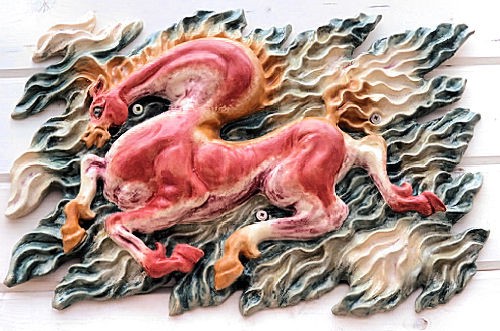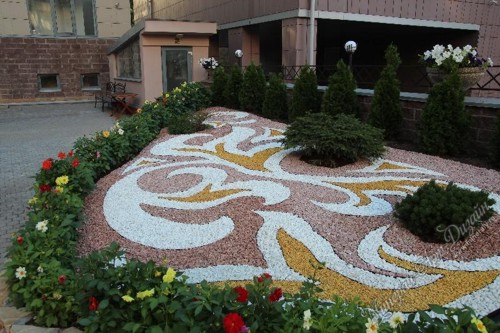Stone crumb is a very unusual natural material, with which you can make an interesting decor of the room. If you look at this type of finishing material, you can see a variety of small pebbles of the same size, most often a round or oblong shape. So that the decorative plaster was kept on any surface, the crushed stone is stirred with a binding component (glue, silicone, polymers).
Content
The babe of stone can have both a natural shade and a certain color that can consist of two or more shades. A stone putty in the form of a thick mass in plastic capacity of 20 and more kilograms is for sale.
In construction stores you can find a popular granite, quartz or marble crumb. By the way, it is a crumb of marble that takes popularity - it advantageously emphasizes any interior.
You can buy a stone crumb in a specialized store or visit Internet sites and choose the material you like, size and shade.
Application area
Most often, the chopped crumb of stone is acquired for finishing facades, basements or for the decor of small areas indoors. Granite and quartz crumb pushes moisture, so it can be used without any problems for external work. Experts recommend using small pebbles when finishing office space, conference rooms, and in residential premises - to cover small areas to highlight a specific area indoors: opening, niche, protrusion, arc, box or rack.
When choosing a popular natural finishing material, its characteristic feature should be taken into account - a cool surface. Therefore, the crumb looks great in the corridors, halls and bathrooms. For external use using stone crumbs, a fragment of the building can be distinguished or covered the entire surface.
Grinding stone is used not only for decor of premises. For example, small-scale granules are used to create a panel. The technique of applying volumetric images is applied, which will give the interior originality.
Natural properties of natural material allow you to work on flat surfaces, as well as create an original landscape design. For such purposes, a large fraction of stone is used. Thus, it is possible to make flower beds with flowers, reservoirs and even garden tracks.
With the help of crushed pebbles, you can create unusual paintings:
Decorative stone crumb is used to finish any surfaces. A feature of this material is a unique ability to change the shade depending on the illumination angle. Naturally, such a coating will not call economical, because the price of stone crumb is equated to the cost of natural stone. In addition, a large amount of material is consumed when applied. For example, for coating one square meter of the surface will have to spend about four-five kilograms of the finished mixture.
Varieties of material
Since the stone crumb is equated with natural plaster, this finishing material is divided by such signs:
- What type of solvent is present in the mixture - organic or with the addition of water base. It is worth noting that the organic type of solvent is currently used often.
- By type of filler. In fashion marble with linations of granite or quartz crumbs. You can find a finishing material consisting of only one component, for example, a quartz.
- By the way painting granules. To achieve unusual shades, manufacturers often combine several natural materials and add granules of different shades.
- The size of crumbs. Depending on the size of the granules, the crushed stone is divided into several groups:
- shallow fraction (from half a million);
- the average fraction (from one and a half to two millimeters);
- large fraction (from three to five millimeters).
- The packaging may not specify the exact size of the fraction, but a group of accessories will be indicated. All granules of the crumb - the streamlined shape so that they do not scratch when in contact and better lay down on the surface. The crumb of one stone, for example, granite - can be produced in several fractions - from large to smaller. The consumption of material and the appearance of the surface treated surface depends on their size. It should be noted that the larger the granules, the greater the material consumption will be.
What are the advantages and disadvantages
Each finishing material has both advantages and disadvantages.
Consider the main advantages of stone crumbs:
- the main advantage of the chopped stone cast is compatible with any surface. The babe fits well on the plastered surface, on wooden, cement and concrete surfaces, as well as walls of drywall and facing bricks;
- material is resistant to temperature drops, mechanical effects, as well as other weather factors (heat, increased humidity, severe frost);
- regardless of which natural stone is a crumb, the treated surface will breathe. Air circulation is achieved due to the special porous material structure;
- large service life. The surface can remain unchanged for thirty and more years;
- in the sun, the crumb will also save its original color, and will not flexin;
- with the help of decorative plastering from chopped stone, you can disguise the surface defect and any irregularities;
- it is quite easy to care for the surface of the stone crumb - it can be washed with a wet cloth and soap solution;
The strength of the crumb of stone is in the first place. But most specialists include this dignity and disadvantages, because if the desire to remove the coating by stone crumb - it will be very difficult, because you can damage the walls. An alternative to this can serve as a new finishing material directly on the "stone" surface.
Disadvantages:
- On store shelves can be found natural water-based plaster. It is undesirable to apply it to the metal surfaces, as this may lead to corrosion. To prevent this, it is necessary to treat metal with anti-corrosion materials in advance. In addition, it is not recommended to apply crumb on the base and surfaces that are not protected from moisture penetration. It is undesirable to cover the crushed stone of places treated with plates from Minvati.
- A permissible high temperature limit is ninety degrees. The surface facing the Sun can overheat. With strong overheating, the binding components of the plaster will begin to soften and the particles of dust are "imprinted", which can then be removed. Latched crumb repair is impossible.
- The crumb of the large fraction contributes to a decrease in vapor permeability, therefore, as the insulation of the "breathable" surface, the crumb is better not to use to even harm even more.
Stone crumb photo:
How to work with the material
To work with a crumb of stone, you will need:
- chit;
- primer mixture;
- putty knife;
- grater, preferably metallic.
First, it is necessary to prepare the treated surface. All visible defects on the walls need to be filled with cement mortar, and the entire treated surface is cleaned of contamination.
The surface before applying stone crumbs must be treated with acrylic primer. Apply it most convenient to the whole foam roller. If the instructions indicate that the tool must be good to soak the wall, then it is better not to rush. To achieve strength, the primer can be applied in two layers, it will help prevent the stratification of the material. If you wish to the primer, you can add a pigment of the same shade as a crumb of stone, then it turns out more "thick" color.
When the walls are completely dried, you can apply a decorative mixture. For these purposes, you will need a medium-sized spatula (when the area being processed is relatively small). If you have to work with large surfaces with surfaces, or to apply crumb on the facade of the building, then experts recommend working "simultaneously", that is, the joints between the layers are not visible. It is impossible to stop for a break and return to work in a few hours.
How to properly apply a stone crumb:
- Take the spatula and apply a small amount of material on the edge.
- So that the material becomes militant, it can be diluted with water. For twenty kilograms of crumbs you need to add one liter of water.
- Distribute the crumb uniformly on the surface. Work with pressure so that the material is well pressed against the wall.
- Wait half an hour. During this time, the crumb should be captured. Now you can take a metal grater and treat the surface. It is no longer necessary to go through the same place in the same place, since the pebbles can shift and will appear. Keep the tool at right angles, heading strictly in one direction. This will evenly smooth out the material. Keep the baby will be about ten o'clock.
That's all. As you can see, it's not difficult to work with the natural crumb. Two weeks, the treated surface can be opened with varnish - it will allow preserving beauty for many years.






























